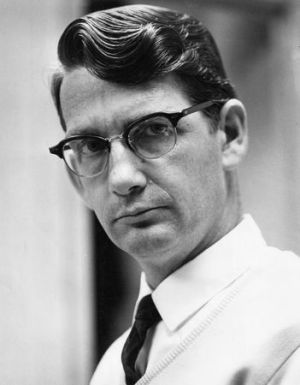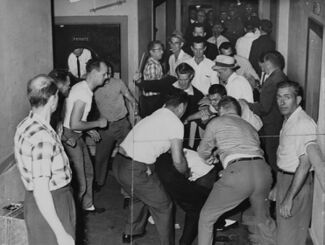Tommy Langston
Thomas Early "Tommy" Langston (born August 23, 1924 in Bibb County; died October 24, 2013) was a photographer for the Birmingham Post-Herald from 1952 to 1989.
Langston grew up in Centreville, graduating from Bibb County High School. During World War II, he served in the U.S. Army Air Corps in the Pacific. After the war, he earned a bachelor's degree in Industrial Management from the University of Alabama. His passion, however, was photography and he became a news photographer for the Birmingham Post-Herald around 1951. He and his wife, Tommie, were married in 1959.
On Mother's Day, Sunday, May 14, 1961, a Trailways bus from Atlanta with Freedom Riders on board arrived at the Birmingham Trailways Station where the Riders were accosted by Ku Klux Klan members and National States Rights Party militants. Accounts vary of how Langston came to be at the scene. In one version he was at Acton's Camera Store near the station when he caught wind of the commotion. Fellow Post-Herald photographer Joseph Chapman recalls that Langston came in before his shift and cherrypicked the bus's arrival from the assignment board, which had been prepped by city editor Duard Le Grand.
Either way, Langston made his way to the station, and snapped an infamous photograph of the mob in action. His flash attracted the Klansmen's attention, and Langston fled as far as the parking lot before he was caught, his camera smashed, and he was beaten. Langston then managed to make it to St Vincent's Hospital. His camera was recovered by a newspaper copy boy, with the film still intact.
LeGrand had Chapman develop the film there, and the photo was published five-columns wide in the next morning's paper. It was one of the first times the Birmingham Civil Rights Movement got significant local coverage. The photo was then picked up by wire services and appeared around the world. It attracted national attention because it showed FBI informant Gary Thomas Rowe in the violent mob. In Japan, the image of uncontrolled racial violence embarrassed businessman and segregationist Sidney Smyer in front of the International Rotary Club. He returned to Birmingham and began working to remove Public Safety Commissioner Bull Connor, who had kept the Birmingham Police Department away during the attack, from office.
Meanwhile Langston and his pregnant wife, Tommie, temporarily moved from their Southside apartment to her parents' in Shelby County. Editor Jimmy Mills had to make a special trip to see Langston and convince him to return to work. Over his career, Langston received numerous awards from United Press and the Associated Press. He finally retired from the Post-Herald in 1989, after 38 years with the paper. Langston was also a member of First Baptist Church of Birmingham.
Langston died after a lengthy illness, survived by his wife, Tommie; a son, Stephen; a daughter, Kathy L. Adkins; one grandson; three sisters-in-law; and several nieces and nephews. He was buried in Montevallo Cemetery.
References
- Patterson, Nick (November 21, 2012) "A quiet, unassuming hero." Weld for Birmingham
- Carlton, Bob (August 4, 2013) "Birmingham 1963: Photographers were on the front lines to capture the civil rights movement." The Birmingham News
- "Tommy Langston [obituary]." (October 26, 2013) The Birmingham News
- Garrison, Greg (November 10, 2013) "Photographer was man of a thousand images, best known for one." The Birmingham News
- Chapman, Joseph (April 25, 2018) personal communication

